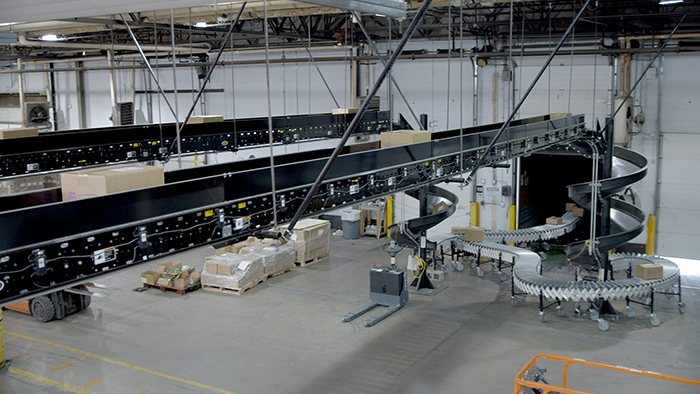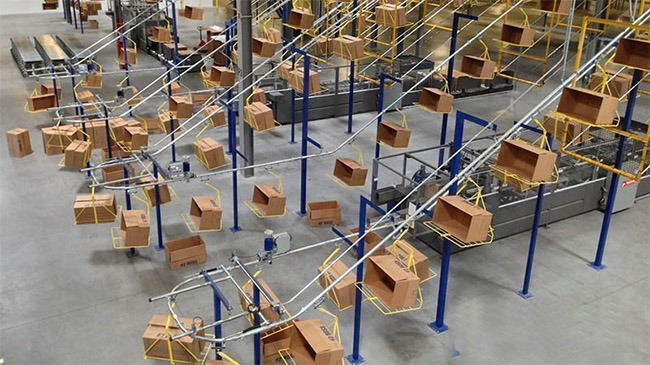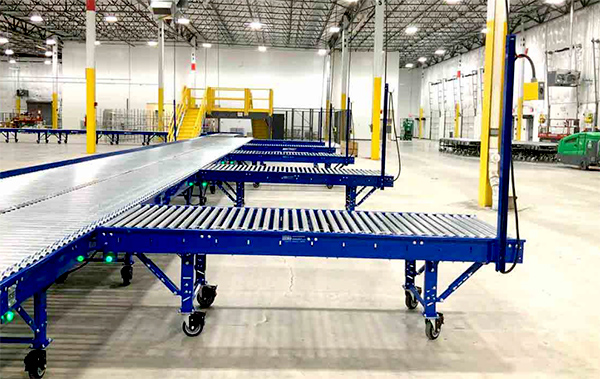Automation and Space: Conveyor Layouts
Space constraints and conveyor system design

Above: Belt conveyors hang from the ceiling of a busy e-commerce distribution center, feeding shipping operations from a pick module while leaving the space below for traffic and shipping activities.
Conveyor systems transform picking, transport, assembly, and more, but occupy space in fixed positions. Tight layouts, low ceilings, facility structures and equipment compromise and compete for that square footage. Don’t worry, though—there are creative ways to work circumvent those limitations–and in some cases make them strengths.
Let’s explore some common space-related conveyor challenges and smart solutions to address them.
Everything you place on your floor competes for space with some other need. It could be simple transition space or reserve storage. It could be forklift lanes or production machinery. Whatever it is, it’s often a sum-zero game when you need to transport products and have other uses for that square footage.
Conveyors can transport, accumulate, move, sort and turn without touching the floor

- You can suspend roller and belt systems from most facility ceilings by suspending them from trusses. The conveyor plus its load height plus clearance between the load and the ceiling plus the space beneath the bed must be calculated into the layout.
- Overhead conveyors, which employ carriers instead of flat conveyors, are another option.They install closer to the trusses, but the product hangs below on carriers.
- The calculation is similar to flat conveyors: the space between the bottom of the lowest-hanging load and elements below it must be taken into account.
- If your product is smaller, low-profile systems can operate on most any warehouse ceiling.
- Safety is a concern with any overhead moving element. You must have a strategy that protects those working below from potential falling elements. You can do this with conveyor netting, under-bed pans, placement and guarding that prevents product spills. See Conveyors and Falling Items for more information.
- Since the conveyor tends to serve as transportation, it won’t compete with vertical storage or other functions in most of these applications.
- Conveyors are versatile; they can run down rack aisles, above machinery, onto or off a mezzanine or around ceiling obstructions.
- In all cases, your trusses and structural ceiling elements must be capable of holding the weight of the equipment.

To execute this strategy, you need to transport materials from floor to ceiling and vice-versa. This means choosing between vertical transport methods like vertical lifts, incline conveyors, spirals or other solutions that move products from the floor to the overhead conveyors. These options use floor space at induction and output points, but that’s minimal compared to floor-installed systems.
More information: Vertical Package Transport: Incline Conveyors vs. Reciprocating Lifts vs. Spiral Conveyors
Ceiling heights have increased, allowing us to take advantage of that space
According to the Blau & Berg Company, warehouse ceiling heights have increased to accommodate modern storage and operational needs.
Typical clear ceiling heights were around 20 feet in the 1980s, but modern warehouses average 30 feet–some up to 40 feet. Warehouses frequently take advantage of in storage areas with taller pallet racks or mezzanines. But between those structural storage and plant elements–in areas where conveyors typically transport items–ceiling space is often there for the taking.
You can install overhead conveyors in low-ceiling facilities but options are limited. Older ceilings in the 20′ range aren’t as flexible or useful as taller ones. With proper routing and layout, you can still use that air space for conveyors, but it’s more of a design challenge.
Above: In this application video, conveyor lines are extended over a busy shipping area from a packing area located on a mezzanine. This allows the free flow of traffic beneath.
Modular, mobile and flexible conveyors

Modular conveyor systems are comprised of power roller conveyors that can be quickly connected, disconnected, moved and rearranged. They adapt to space-starved layouts and variable-need areas like docks and assembly.
These systems are simple to move, connect, disconnect, and rearrange as needed. They are built with straight runs, merges and diverts that let you configure the conveyor to the needs of the moment. These systems tend to work best at dock areas, which may require higher throughput one day and floor space for unloading the next. They work well with extendable and flexible conveyors in loading areas.
Advantages and limitations
- Time is needed to set up and configure a modular system.
- Modular conveyors are flexible and scalable. You can add and remove curves or straight sections when you need them to fit the demands of the moment.
- Capacity may be an issue. Modular conveyors may not be useful for heavier, larger items. They cannot convey pallets, for instance.
- They can be deployed easily and quickly to serve a need, then moved away when that floor space is needed for other functions.
- When your needs are complex, modular conveyors accommodate them as well as a fixed system. You can only use the sections and sizes of conveyor on hand rather than build out a flow that is custom to your needs.
- Portability is built into modular systems, with wheels on each section. They seamlessly connect, power and integrate with each other.
- Modular conveyors may be more sensitive to irregular, uneven floors since they cannot be as easily shimmed to level the conveyor.
- Maintenance is easier and less demanding, as modular systems are easy to access and repair when necessary.
- While they can save space in a given area, they must occupy other areas when not in use. That storage space can be more compact and efficient than a permanent installation.
Modular plug-and-play conveyor system have significant advantages in terms of flexibility, ease of use, and scalability. They occupy less space and give you the ability to dial up conveyance when and where you need it. However, they are limited in load capacity, durability, and cost-effectiveness for highly demanding or specialized applications.
Other factors for conveyor space
- Shared space with machinery and other equipment: Conveyors compete for space with machinery but often must feed or take away from it. This can lead to operational conflicts and ineffective layouts if not fully evaluated in the warehouse design. Finding ways to reduce the footprint of both the conveyor and associated machinery is critical to good floor space utilization. Designate areas for your machinery and integrate conveyors into that design. Consider more compact machinery when that’s feasible.
- Unusual building spaces: Sometimes your layout isn’t as easy as a standard square or rectangular building. We’ve built projects where conveyors must punch through a wall or snake around unusual corners or shapes. Modern conveyors can curve and switch when designed to deal with the unique considerations and dimensions of your building.
- Traffic flow, safety and crossings: Design your conveyor system with pedestrian and forklift pathways in mind for both safety and space efficiency. You can design WMS systems that evaluate traffic flow to safely maximize throughput. You can also design crossing points or underpasses that reduce these conflicts. Read more: Crossing Conveyor Lines: The Options.
- Service and maintenance access: In space-constrained facilities, accessing conveyors for maintenance or repairs may be challenging, leading to downtime and inefficiency. If you design purely for space efficiency, that access becomes more difficult and may lead to consequences down the road. It’s always a balance.
Space is often a complex and difficult subject for industrial operations
Storage is the chief occupier of that space in most cases, and it can be optimized. Transport, storage buffers and machinery also occupy significant space. Optimizing those areas can help you prevent expensive relocations or built-in inefficiencies. Whether you’re considering a new facility or need to reconfigure your operation, space optimization is possible and always worth the effort.
Read more
- How to Handle and Remove Corrugated Box Waste in Distribution Applications
- How to Set Overhead Conveyor Clearances
- AGVs, AMRs, and Conveyors: Automated Product Transport Applications
Scott Stone is Cisco-Eagle's Vice President of Marketing with 35 years of experience in material handling, warehousing and industrial operations. His work is published in multiple industry journals an websites on a variety of warehousing topics. He writes about automation, warehousing, safety, manufacturing and other areas of concern for industrial operations and those who operate them.



